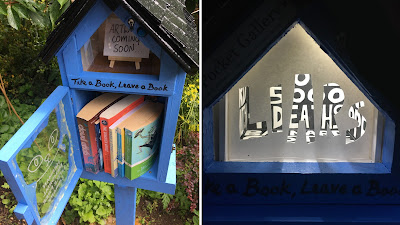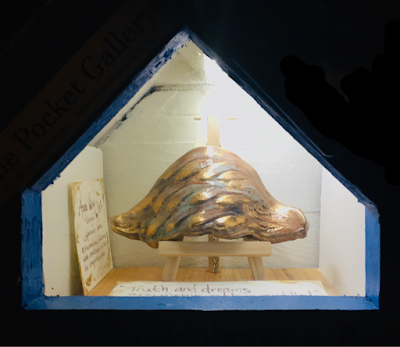Some of you might be aware that I was a panellist for an online Folkestone Book Festival event featuring gardener and author Frances Tophill, talking about rewilding garden spaces.
I appear at about 29 minutes and talk about Payers Pocket garden and how this influences my work with Folkestone Harbour Yarn. Anyone who has seen the event will know that my sound kept dropping out throughout the talk, so here is a transcript of what I actually said!
Talk starts here:
Hi, I'm Suzi Ashworth from Folkestone Harbour Yarn. I dye yarns and I also look after Payers Pocket Community Garden.
1st slide, which is my logo, shows quite a few yarns dyed with some of the things I have grown in payers pocket. At the top is blue which is woad, then we go mugwort green, then tansy which is the yellow, and then we move into the pinks and oranges which are from madder, which I also grow in the garden.
2ns slide is Payers Pocket garden. It's a very very small space behind the Quarterhouse in the heart of the creative quarter. I started working on it 2018, making a small area for me to grow dye plants there. So I use what I do (grow) for natural dyeing.
3rd slide. I grow things like... oh there we go! There is a great big bucket of woad leaves which are invaluable really, because they are the only native plant that can produce blue dyes. People have historically imported indigo from the east, but woad, which you probably know from things like braveheart and celts smearing themselves with it, produces, after processing, a fantastic blue colour and I can grow it rather than have to pay for it.
5th slide. During the last lockdown those of us who use the garden realised that most people in the area live in flats and they didn't have an outdoor space, so we formed Payers Pocket Community Garden to make people aware of the space and encourage them to use it. What we have here is another organisation in Folkestone called Last Friday's. So they webcast... they were livestreaming this musician playing in the garden on the last Friday of the month, so that was really fantastic and helped people see a little bit about what we were doing. And it was just a really nice use (of the garden). This lady is actually a really fantastic professional viol player and recording artist called Asako Morikawa, who, if you're into your classical music you will have heard of her. She does live in Folkestone and it was a real honour to have her there.
6th slide. The other thing that we do in the garden, or that I have put up in the last year, is the very grandly named 'Herman Memorial Little Free Library' and The Pocket Gallery. So this is a miniature library, because the public library was closed during the last lockdown, and it has a very, very tiny little art gallery in the top, which I curate. Every 2-3 weeks a new artist comes along and puts a miniature piece of artwork in there, which is quite challenging for them because it is tiny. It's about 18cm wide. It is a 'proper' gallery, it has lighting and an oiled wooden floor, but the nice thing about it is that even though it's tiny and its cutesy, it's like a cute little dolls house, people haven't put cutesy toned-down artwork in there. This one on the right is by an artist called Charlotte Chapman and this was her reaction to some of the political discussion and the headlines during the first pandemic, sorry lockdown, we're still in the pandemic!
7th slide. But the most important thing we do is encourage wildlife. So this is a pallet structure that we built called 'Buggingham Palace'. This is our giant bee hotel, so there's several layers there and there are succulents there on top to protect it from the weather. Everything in the garden, because I have no budget, is reclaimed. It is made from things that people have chucked away, people have left, so its not the tidiest looking garden but this is a pile of pallets that we have transformed and it's done really well, I think. There are quite a few creatures and creepy crawlies wintering in there now.
8th slide. One of the other things I have in the garden is a wildlife camera. So this is one of the young foxes having a good old sniff, seeing what we are doing. There are a few main things that we have done to encourage as much wildlife as possible. Firstly I tell anyone using the garden that it is a chemical free garden, so I discourage the use of pesticides, chemicals, things like that. It's not really a manicured, controlled space, we pretty much let things grow where they want to. Somebody put some tomatoes in the compost and I spread it out this year, and we ended up with random tomato plants all over the place. It was quite funny. The centrepiece really is the compost heap, I won't show you a photo of that because nobody wants to see a big rotting compost heap, but I'm quite proud of it.
9th slide. We have a very small water feature but we are going to work on that very, very soon, putting in a larger pond area and that's about it really. I cant remember what that (slide) is, oh! That is our one tiny little water feature, it is essentially a bowl on a stick, and there is a female blackbird, again having a look at our wildlife camera.
10th slide. There we go. This is a beautiful, beautiful rosemary beetle that I got a great shot of, and one of the local squirrels. I have noticed (the squirrels) using the space more and more this year, but that might just be because I'm paying attention! One of the things that I do in the garden is I use an app on my phone called Seek by iNaturalist. So I wasn't exactly sure about this species of beetle, but you can scan it, it will feedback the information, It is related to WWF (world Wildlife Fund) and National Geographic (I'm not paid for promoting it or anything like that!) but its really useful if you don't know what the species is. Seek is the name of that, and its been really helpful. Um, I think I'm repeating myself and I've come to the end of it so... that's Payers Pocket Garden!

















.jpeg)